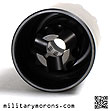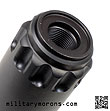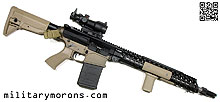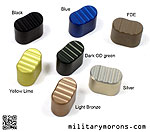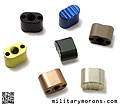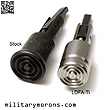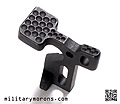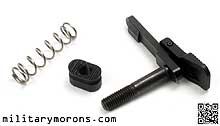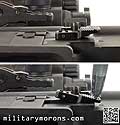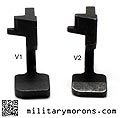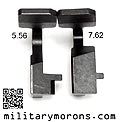AR15 Accessories Page 1 Page 2 Page 3 Page 4 Page 5 Page 6 Page 7
TO VIEW FULL SIZE IMAGES: USERNAME and PASSWORD are both "mm"
Griffin Armament 7.62 Taper Mount Flash Comp and Blast Shield
4/25/15 - Here are two 7.62 items from Griffin Armament: their 7.62 Taper Mount Flash Comp, and the Taper Mount Blast Shield. The Flash Comp features Griffin's Universal Taper Mount which is compatible with their Recce, PHS and Sportsman Suppressors. The Taper Mount Blast Shield directs the muzzle blast forward, reducing the concussion to the user or others to the side or behind the shooter. 7.62 Taper Mount Flash Comp - The 7.62 Taper Mount Flash Comp is a similar in design to the updated Flash Comp featured previously; except that it's upsized for use with 7.62mm weapons and has Griffin's Universal Taper Mount for compatiblity with their taper mount suppressors. It's also available in a 5.56mm version, with slightly different dimensions, but the main features are similar. The Taper Mount Flash Comp is CNC machined and OD ground from high strength, precipitation hardened, 17-4 stainless steel. The 7.62 version has 11 rows of 7 ports (total of 77 ports) vs 50 (10 rows of 5 ports) on the 5.56 version, that are .078" in diameter and have .025" chamfers. It is closed on the bottom. The openings between the front prongs are located at 12 o'clock, 4:30 and 7:30 (120° apart). The Flash Comp comes with a shim kit, for timing the comp. Since it's a Taper Mount, it doesn't come with the overtravel stop that Griffin's other devices come with. A knurled thread protector is supplied with the comp, which installs just by hand tightening it. The inside is tapered, so that it matches the taper on the rear of the comp. Standard 3/4" wrench flats are provided for installation, just ahead of the taper and behind the mounting threads. Taper Mount - Griffin utilizes a semi-locking taper design on this comp and compatible suppressors, which in this case is a taper machined onto the outside of the mount and the inside of the suppresssor. When the suppressor is installed and tightened down, the tapered mating surfaces rely on friction such that the suppressor will not loosen under vibration. I asked Griffin for a bit more information, and this is what they had to say about it:
Some of the key features of the 7.62 Taper Mount Flash Comp are:
Installation - The 7.62 Taper Mount Flash Comp comes with a shim kit, which includes stainless steel shims of two different thicknesses; .002" and .010" thick. Combining shims allows the user to achieve the correct clocking of the muzzle device. The torque spec is about 30 ft-lbs.
|
Taper Mount Blast Shield - The Taper Mount Blast Shield is a is a quick attach/detach muzzle device that offers significant concussion reduction for the shooter and other people to the side or behind the shooter by directing the majority of the muzzle blast and noise forwards. It is the Taper Mount cousin to Griffin's QD Blast Shield. Rather than the tri-sided cross section of the QD Blast Shield, the Taper Mount Blast Shield is circular. Some of the key features of the Linear Comp are:
The Taper Mount Blast Shield is a removable shroud that attaches over Griffin's Taper Mount muzzle devices to reduce concussion and noise heard/felt by the shooter and any other people to the shooter's side and rear. When shooting out in the open, without other shooters around, muzzle blast/concussion and noise are of concern only to the shooter. Not everyone can own suppressors, but some may shoot in confined quarters (like a shoot house or indoor range) or alongside other folk in a class or range. Most compensators designed to reduce felt recoil or muzzle movement do so by directing the expanding gases to the sides or top (some even slightly rearward). In doing so, noise and concussion is typically increased to the shooter and those off to the side, resulting in a trade-off between the desire for increased muzzle control and causing discomfort to fellow shooters. There is also the effect on the shooter's hearing. The Taper Mount Blast Shield offers a convenient remedy for the times when reduced side concussion and noise is desired, but the shooter doesn't want the inconvenience of swapping out his compensator, or doesn't have access to a suppressor. It attaches to the existing muzzle device and encloses it on all sides completely, allowing gases to escape only to the front. It works in a similar fashion to linear comps or blast directors, which are designed to direct noise and concussion forward of the shooter. The Taper Mount Blast Shield allows the shooter to retain the muzzle-controlling device, and quickly convert it to a low concussion device depending on the situation or need. It's especially effective on short barrels, where blast and noise are increased over longer barrel lengths. A 7.62 weapon has more concussion than a 5.56 one, so it's good to have a Blast Shield on hand when shooting next to folks. The Blast Shield has an internal taper that matches that on the Taper Mount Flash Comp. It's threaded internally to engage the threads on the comp. It's install simply by screwing it on and hand-tightening it down. Grooves at the rear provide grip when tightening or loosening it.
|
|
Notes/Observations - I mounted the Taper Mount Flash Comp on a Rainier Arms 7.62 upper which features a 16" barrel and Syrac Ordnance adjustable gas block. I had adjusted the gas block such that it let just the right amount of gas into the system to be reliable, without being overgassed (in this case one extra 1/4 turn past lockback on an empty mag). 7.62 obviously has more recoil than a 5.56 rifle, so I found the Syrac gas block to be handy as the Rainier barrel tended to be overgassed. I built this rifle with a Vltor A5 receiver extension, standard carbine H3 buffer, and a Tubbs flatwire buffer spring I had laying around. Typically a 7.62 AR using a standard carbine receiver extension utilizes a shorter, special 7.62-specific buffer, but I had the A5 parts already. With no muzzle device attached to the barrel, it just kinda jumps around a bit based on how I'm supporting the rifle, as the gases aren't being directed anywhere in particular. The recoil impulse is pretty much straight back. With the Taper Mount Flash Comp installed, exiting gases are directed purposefully and I felt that the muzzle is easier to keep on target after each shot; just like on the 5.56 rifles. Felt recoil is reduced slightly, but not to 5.56 almost non-existent levels. A dedicated muzzle brake would be needed for more felt recoil reduction. Concussion with the Flash Comp to the shooter is a bit sharper than without a muzzle device. With the Blast Shield installed, the felt recoil is increased (with is to be expected as the gases are now directed forwards), but the concussion is directed towards the front, and the 'boom' is lower pitched/deeper sounding. Kinda of like the report of a .45 vs. a 9mm. The concussion is greater to someone standing to the front when the Blast Shield is installed, but reduced to shooters standing to the side and behind. It's a good device to have on hand when shooting with others on a line. If removing/installing the Blast Shield or thread protector in the middle of a shooting session, be sure to wear gloves as all parts can get really hot. I did not have any issues with the thread protector nor Blast Shield loosening up when shooting; nor did I have a problem removing them. Shooting with a suppressor for extended periods might be a different story so the manufacturer's recommendations should be followed. The inside of the Blast Shield and outside of the Flash Comp do get dirty from carbon when used together, but clean up with FireClean afterwards proved to be relatively easy after about 250 rounds downrange.
|
Battle Arms Development Enhanced Magazine Release Button
5/16/15 - The BAD-EMR (Battle Arms Development Enhanced Magazine Release) from Battle Arms Development is a replacement for the stock magazine release button. It features an improved ergonomic feel and is compatible with all lower receivers that accept mil-spec magazine release buttons. Description - The BAD-EMR is a drop-in replacement for the stock magazine release button. It features a fully solid "V" shaped button face with horizontal serrations and no through hole. The BAD-EMR is taller than the stock button by about .075" by my measurements. The stock button is about .302" tall and the BAD-EMR measures .378" at its tallest and .348" at the bottom of the concave. The BAD-EMR is precision CNC machined from billet 7075-T6 Aluminum (not 6061) and available in a a variety of anodized colours: Black, silver, Red, Dark OD Green, Light Bronze, Yellow Lime and Blue. It's also offered in cerakote FDE (Flat Dark Earth). The red button was out of stock at the time of this writing which is why I didn't feature it here. The back of the BAD-EMR has two skeletonizing holes to offset the weight gained from the fully solid button face and slightly increased height to equal the weight of the standard mil-spec magazine release. The BAD-EMR is compatible with all lower receivers that accept mil-spec magazine release buttons. Installation - The BAD-EMR installs exactly like the stock button does, except that it only takes 6 turns of the magazine catch to bottom out vs. 7-8 turns for the stock button. Notes/Observations - The BAD-EMR buttons are beautifully made and finished. They're really much nicer than the regular stock buttons, and have no sharp edges. The concave 'V' shape really does make a difference as it helps center the finger in the button. Even if it doesn't, it provides better tactile feedback as to where the center of the button is, vs. the stock flat button. With the stock button, it's the edges that tell you whether you're completely on the button. That being said, I don't think I've ever missed the button with my finger as my finger 'knows' where it is after shooting an AR for over 30 years. I'm a lefty though, and until ambidextrous magazine catches were available, I used my right thumb to depress the magazine button. The BAD-EMR does feel better though, and I do appreciate the slightly extended height and better tactile feedback. The horizontal serrations also keep the finger from slipping off should you catch the edge of the button. One of the questions asked is whether the extra protrusion of the BAD-EMR above the fence due to its taller profile increases the chance of accidental mag release when laid on a hard surface. If it's a flat surface like a table, the answer is 'no'. In the photo below, I've illustrated two different rifles equipped with the BAD-EMR, laid on their right sides on a table. The rifle at the top of the photo has a forward assist, while the one below it doesn't. In the top photo, the points of contact with the ground are the forward assist plunger and the pistol grip. In the lower photo, the points of contact are the pistol grip and shell deflector. The BAD-EMR is about half an inch from the table in the upper photo and about .3" from the table in the lower photo. If there's something sitting on the table, or you lay the rifle down on an uneven surface with debris or rocks sticking up, then sure, the BAD-EMR might be pushed in and activated. So might the standard mag release if the object is small enough. If the object is larger than the fence, there' a chance the standard mag release won't be pushed in enough to release the mag, while the BAD-EMR might. It's not something that would concern me. Cosmetically/aesthetically, it looks so much better than stock, and the different colours that they're offered in add a nice touch. I found that the Light Bronze matched the laser engraving markings on my KAC lower receiver nicely without being obtrusive. At only about $7 a pop, there's no reason to get the stock button for a new build over the BAD-EMR. |
Forward Controls Design AR Accessories
7/23/15 - Forward Controls Design (FCD) has introduced three new items for the AR-15; enhanced magazine release buttons, an improved bolt catch and a low profile forward assist. Forward Controls Design is a new company started in 2014 by former Battle Arms Development partner Roger Wang, so readers will naturally see the similarities in design philosophy and execution between FCD's and BAD's products. FCD's goal is to create a better user-centric, form fitting and logical suite of AR-15 and SCAR components with ergonomics as one of the main design goals. Seemingly small changes to common weapon controls, such as the direction of serrations or a slight change in shape can make large differences in the way they feel and how the user interacts with his firearm. Enhanced Magazine Releases - Two different Enhanced Magazine Releases are offered: the EMR and the EMR-C. Both feature a slightly curved button surface to fit the natural curvature of the finger, along with horizontal grooves, serve to create a self-centering surface that inhibits the finger's vertical movements. The EMR has a milspec through hole and is .020" taller than the stock magazine release button, with minimal protrusion past the standard forged receiver fence. The EMR-C (Competition) is the taller version of the two, and is .04" taller than the stock magazine release and protrudes about .08" above the button fence on a milspec receiver. It's easier to access due to its taller profile. It doesn't have a through hole. While magazine buttons are already light weight components, the EMR and EMR-C have a shallow band/groove around the body to reduce weight and bring them closer to the factory button weight. Both the EMR and EMR-C are machined from 7075 T3 aluminum and Type 3 Hard Coat anodized. The EMR and EMR-C are installed in the same way you'd install the stock magazine release button. Being a lefty, I only use the magazine release button on the right side with my thumb (if I don't have a Norgon Ambi-catch on the receiver). That being said, I do practice support-side mag changes and shooting, and the curved shape of the EMR and EMR-C do help let the finger know exactly where it is on the button, and also helps keep it in position. Personally, I like the look of the EMR-C without the through hole better, as I do with the Battle Arms Development BAD-EMR. Since Roger worked on the magazine release when he was with BAD, it shares the same curved surface. The FCD button's serrations are slightly finer but more aggressive/sharper in the texture. Low Drag Forward Assist (LDFA) - The LDFA was specifically designed and purpose built for AR15s and M16s with ambidextrous charging handles. When using an ambidextrous charging handle, the right side of the handle is often pinched between the thumb and 2nd joint of the index finger. The forward assist on the right side of the receiver is right below the rearward path of the charging handle and hand, and the rim on the end of the forward assist plunger can snag a fingernail or scrape the skin off a finger joint as it brushes over it. I've done this a few times before which is why I wear gloves when shooting. The LDFA offers a smaller footprint over the factory forward assist plunger. It lacks the rim at the end of the plunger and has a smaller footprint and snag-free design. The smaller footprint does not impact its functionality when needed. Typically, I build my upper receivers with Vltor MURs, which have the forward assists located further forward on the receiver, putting them out of the way. But any standard upper receiver will have the forward assist and the LDFA is a good option for those who don't want to swap out the entire receiver to address the issue. The shallow groove around the body of the LDFA serves to break up the outline of the plunger, because with the traditional rim removed, it looks longer than it is. The end of the plunger retains the stock concentric circular serrations. The LDFA plunger is CNC'd out of 4340 steel bar stock and is parkerized. It's lighter than the factory plunger; it weighs 0.679 oz vs. 0.715 oz. Also shown here is the titanium version of the LDFA; the LDFA-Ti. It's machined from Grade 2 bar stock Ti and weighs 0.430 oz. It's unfinished, and I've asked whether a darker, more subdued titanium grey could be offered. I like the idea of a lighter part; but don't want it to be so shiny and bright. The LDFA comes with a replacement spring and roll pin for installation. Installation is exactly the same as for the factory part. The LDFA is illustrated below installed on an LMT MRP upper receiver, which has the standard forward assist assembly. The LDFA is the same length as the factory plunger; it just lacks the rim at the end. The lack of a rim eliminates the possibiliy of snagging my fingernail or scraping my finger joint on the forward assist plunger as I pull back the charging handle. Plus, I like its looks. If you're a lefty and use standard receivers, you'd be doing yourself a by installing a LDFA in your uppers. Augmented Bolt Catch/Release (ABC/R) - The ABC/R is an augmented bolt catch/release lever that features and angled, larger top paddle and lower paddle with increased surface area. It's purpose designed for AR15 receivers equipped with ambidextrous magazine releases. Many of the ambidextrous mag releases are on the same vertical plane as the bottom paddle of the standard bolt catch. This can make identification of the two controls difficult by feel, especially with a gloved hand. The lower paddle on the ABC/R protrudes out further, and is angled at 10 degrees to give it additional surface area. This puts the lower paddle and that of the Norgon Ambi-catch shown here on different vertical planes, making it easy to differentiate between the two. The bottom of the paddle acts as a 'stop' for the finger when accessing the ambi-catch. The top paddle is also larger than the stock paddle, with the top of the paddle canted at 10 degrees out, and the lower half canted at 5 degrees. The angled paddle makes it easier for the palm or thumb to access. As a lefty, the extended paddle and angle makes it easier for my left middle finger to actuate and release the bolt carrier. I do not slingshot the charging handle normally and prefer to utilize the bolt release instead. Horizontal serrations on the top and lower paddles provide traction for the fingers. The V-notch immediately above the ABC/R's lower paddle is there to provide tactile feedback to indicate the beginning of the lower paddle. This is something I recommended be included, just like on the stock catch, rather than have a smooth transition from top paddle to bottom paddle. I have a couple of Armalite bolt catches (seen below to the right) and the top paddle and lower paddle are on the same vertical plane. After using them for a while, I grew to dislike them as the flat surface didn't give me a good index on where to push down on. The ABC/R is shown below next to the stock bolt catch, and a Seekins Precision bolt catch just for comparison. While the Seekins has an extended lower paddle, it lacks the angles and notch that help provide the degree of control and feedback that the ABC/R does. The ABC/R has lightening cuts (the slot in the body and hole in the lower paddle) to keep the weight close to that of the factory bolt catch. The ABC/R is a direct replacement for the stock bolt catch and installs in the same way. I've illustrated it below on a Battle Arms Development BAD-556 light weight lower receiver. The ABC/R weighs 0.445 oz (vs. the stock weight of 0.401 oz) and is made from billet 17-7 stainless steel and Melonite coated. As a lefty, I definitely like the feel of the ABC/R better than the stock bolt catch. The angle and size provides better traction and leverage for my fingers. The angle also ensures that the top paddle is not going to contact the upper receiver and make a mark. So far, it's compatible with all standard and billet upper receivers. Right-handers will also appreciate the ABC/R as well. 1/22/17 - The ABC/R-AA (Augmented Bolt Catch/Release - All Angles) is a variant of the ABC/R with dimples on the control surfaces instead of horizontal serrations. Everything else is the same. The horizontal serrations on the ABC/R provide traction in the vertical direction, but not so much along the direction of the serrations. With the ABC/R-AA, the dimples provide the same traction for the finger no matter the direction, hence the 'All Angles' designation. The AA actually has three dimple sizes and depths; 30 dimples in total. The dimples are all enclosed within the area of the paddles; they don't extend off the edges which would result in partial dimples. This was more of an aesthetic choice which doesn't affect function. Comparing the original ABC/R and the AA, I found that the dimples have slightly less traction than the serrated model, in the vertical direction. The serrations have a little more 'bite'. In the horizonal direction and other angles, the AA has the advantage. One thing I would like to see is the dimples closer together so that they overlap to create points, and increased traction. As a lefty, I've always used my left index finger to actuate the bolt catch. I actually don't find that I need additional traction along the horizontal direction, and the serrations are very effective as they are. However, right-handed users may actuate the bolt catch differently from me, and appreciate the non-directional texture of the AA variant. Either way, it's a cool-looking variant of an already functionally-improved part. 6/9/17 - Enhanced Magazine Release - Ambidextrous (EMR-A) - The EMR-A is an ambidextrous magazine release for .223 and .308 AR-15 receivers. It gives the user a choice of a standard or extended length lever, which features FCD's 'Multi-faceted Control Surface'. The EMR-A is an original concept and design from FCD; a couple of years in the making. It has a lever that when pressed, pivots off the receiver and lifts the magazine catch away from the receiver allowing the magazine to drop free. The lever is available in two sizes; the standard shown here, and the extended reach (about .09" longer than the standard). Note that the EMR button shown here is not included, but available as a bundle. The extra power magazine catch spring is included with the EMR-A. The EMR-A compliments the ABC/R (Augmented Bolt Catch/Release), as the ABC/R was designed to work with ambidextrous magazine releases. Arguably, the most prolific ambi mag release is the Norgon Ambi-catch, but its paddle's small surface area and proximity to the bottom of the bolt catch can be the source of possible inferference, especially when used with gloved hands. The lower paddle on the ABC/R protrudes out further, and is angled at 10 degrees to give it additional surface area. This puts the lower paddle and that of the Norgon Ambi-catch on different vertical planes, making it easier to differentiate between the two. The EMR-A takes it a step further by locating the finger pad of the lever just aft of the lower paddle of the bolt catch, providing greater separation for the two control surfaces and further reducing possibility of confusion or inadvertent actuation of the wrong control. The finger pad of the lever has what FCD refers to as a 'Multi-faceted Control Surface' (MCS). Instead of a flat surface with serrations, the finger pad has three separate planes to provide a natural index point and additional traction for the finger. 80% of the pad is split horizontally into two V-shaped surfaces, and the rear 20% is flat. The horizontal split centers the finger vertically. The rear flat is also raised slightly above the V surface, for better traction. It's subtle looking, but can readily be felt and makes a big difference. This attention to detail and making incremental improvements to existing designs is what FCD is known for. A 10.9 lb extra power magazine catch spring is included with the EMR-A. FCD included this as they felt that the standard spring is a bit weak. A stronger spring reduces the likelihood of accidental mag drops without making the lever too stiff to press. The EMR-A's catch is made from CNC machined 4140 steel and black nitride coated; and the lever is 7075 aluminum with a Type 3 hard anodized coat. Installation and removal is in the same manner as the factory magazine catch, and the EMR-A is compatible with all standard receivers and bolt catches. The Norgon Ambi-Catch has been my go-to ambidextrous magazine release for over 20 years. I had two issues with it: the high price, and the small finger pad. At an MSRP of $90, it was expensive to equip multiple lowers with it. Over the years, I tried out alternatives. Each one had to rely on a different method of operation than the Norgon because Norgon had the patent on its design (now expired). This required the levers to pivot off the receiver, which would leave a mark at the point of contact. The Norgon lever pivoted off the catch, thus leaving no marks on the receiver. The Troy Ind used a lever positioned forward of the bolt release. I have short fingers and the finger pad on the Troy was just too much of a reach to feel natural for me. I also tried the Knight's Armament Corp ambi mag release, which took the opposite approach and located the finger pad way behind the bolt release. It was located so far back that it required my finger to be bent unnaturally to actuate it. With a finger bent like that, the natural movement is pulling (as with the trigger), but pushing felt very awkard to me. Some people love the KAC; I personally felt that it was the least ergonomic design I had tried and promptly removed it after trying it out. The Norgon finger pad is located right below the bottom paddle of the bolt release. It's located naturally (for me), but very close to the bolt release. When I had talked to George (BAD) and Roger (FCD) a few years ago, I had expressed my wish for an ambi mag release to be just like the Norgon, but with a finger pad that was extended back a bit and larger (just like the proprietary magazine catch on the AXTS AX556 ambi receiver). Back then, the Norgon patent had not yet expired, so the designs had to pivot off the receiver. Even after the patent expired, FCD decided not to copy Norgon's design but to continue with their own (which I respect), and have essentially come up with a finger pad sized and placed exactly where I wanted it. The EMR-A positions the finger pad just behind the bottom of the bolt catch, and it's about .45" long and wide. For me, it's the perfect size and location. It's easy to reach, and the slight V shape and step on the pad really does make a tactile difference. The only thing that keeps this from being perfect is that it may leave a mark on the receiver where the lever pivots on. But, as Forward Controls has stated, this component was designed for a combat weapon; for folk that won't lose sleep over a small mark on the receiver. So for now, we'll just have to settle with almost perfect. 4/1/18 - ABC/R v2 and Dimpled EMR-A - The ABC/R previously featured has been updated with a version 2 (v2). The Version 2 has the following changes: Deletion of the lightening cuts, and a 10% thinner/tapered upper paddle to better clear wide billet upper receivers. I had suggested the tapered paddle design a while ago and FCD implemented it. The thinner/tapered paddle lightens the weight of the part while providing more clearance in the back. To match the ABC/R-AA (All Angles), a dimpled version of the EMR-A has been released with a dimpled lever shown below. Now you can pick between serrated or dimpled matching sets of the bolt catch and magazine release. The dimpled magazine button is almost exactly the same as the serrated one, except that it is .009" shorter. The EMR-A is an original concept and design from FCD; a couple of years in the making. It has a lever that when pressed, pivots off the receiver and lifts the magazine catch away from the receiver allowing the magazine to drop free. The lever is available in two sizes; the standard shown here, and the extended reach (about .09" longer than the standard). Note that the EMR button shown here is not included, but available as a bundle. The extra power magazine catch spring is included with the EMR-A. 7.62 ABC/R v2 - Forward Controls Design also offers the ABC/R v2 in a 7.62mm version for LR308 pattern ARs. It's available with either serrated (shown here) or dimpled paddles. The bolt catch is machined from billet 8620 alloy steel and heat treated, with a black nitride finish. I installed the FCD unit on my .308 lower (replacing the Armalite bolt catch) and the angled paddles really aid in operating the bolt catch with my index finger (I'm left-handed). The Armalite version is flat, without any separation between the lower and upper paddles. The lower I have is non-standard, and the 'fence' on either side of the bottom paddle limited access to it. With the extended/angled lower paddle on the ABC/R, it's much easier to depress now. There is also ample clearance from the top paddle to the cutout on the Rainier Arms upper I have. Definitely an improvement over the Armalite bolt catch. The EMR-A is an original concept and design from FCD; a couple of years in the making. It has a lever that when pressed, pivots off the receiver and lifts the magazine catch away from the receiver allowing the magazine to drop free. The lever is available in two sizes; the standard shown here, and the extended reach (about .09" longer than the standard). Note that the EMR button shown here is not included, but available as a bundle. The extra power magazine catch spring is included with the EMR-A. EMR-A Extended Lever and LP shaft option - On the standard EMR-A, the customer has the choice of the standard length TDP-spec shaft, or the LP (Low Profle) shaft. The difference in shaft length is only .030" with the LP being one thread/full rotation shorter. The reason for this option is to allow the TDP spec mag release button to sit flush with the magazine fence on the right side of a mil-spec receiver to prevent an accidental activation of the mag button. Extended magazine release buttons on the right side are not recommended if accidental activation is a concern. The EMR-A is also offered with an extended lever/button, which is 0.11" longer than the standard EMR-A. Normally, I wouldn't bother, as I can reach the lever on the standard EMR-A easily, but it's definitely beneficial for kids like my 10 year-old son, who has little hands and fingers. He's also a lefty like me. The standard EMR-A enabled him to reach the lever as his finger was too short to reach a Norgon Ambi-catch. The extended EMR-A is even easier for him, and he can maintain a natural grip on the pistol grip instead of reaching for it. I had originally thought that the KAC ambi mag release might be a good choice for him, but even that put the lever too far rearward and was too awkward for him to activate. The extended EMR-A is perfect for him. Forward Controls has also introduced their CNF (Castle Nut, Forward Controls). How do you improve on a castle nut? By really delving into the details. FCD increased the number of staking notches from 3 on the mil-spec castle nut to 4. The notches are equally spaced. This is simply to give the user more staking locations, given that the castle nut is supposed to be staked in two places. The mil-spec castle nut works fine, but when combined with some aftermarket receiver end plates, like the Vltor one illustrated below, it's possible to have only one notch available for staking as the other two are on the side where the sling loop is, or on the bottom. FCD also made small changes to the notches. They changed the angle from 45 to 30 degrees, resulting in 25% longer and deeper notches than the mil-spec castle nuts. This gives the staked material more room to deform and theoretically provide a more secure stake. FCD also added coarse serrations (the scallops) to aid in rotating the nut towards the end plate during assembly. I've never had an issue with the wrench cutouts, but the scallops look a bit different, and don't hurt its function. The CNF is billet machined in 4140 PH steel and black nitrided.
|
/ . PLEASE
OBSERVE AND RESPECT OUR COPYRIGHT! . /
©opyright by MilitaryMorons.com. All Rights Reserved. Reproduction, Duplication,
Distribution Strictly Prohibited.
Unless mentioned otherwise, content and images are the
property of militarymorons.com and are not in the public domain.
They are not to be used without
permission. Please Contact
me for permission to use any images or content herein.










